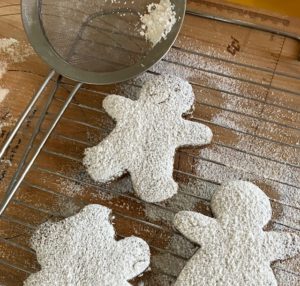My mother decorated a gingerbread house a few years ago and she said it was so much fun! (That is her in the photo above and she was around 90 at the time.) It sat in her living room throughout the holidays and she was so proud of it.
Whether we make gingerbread cookies to eat, or gingerbread to make houses with for decoration, gingerbread can be a joyful activity during the holidays. The aroma of gingerbread baking in the oven can make the house smell amazing.
Cookies can be fun to make during the holidays. My children and grandchildren and I love to cook together when we get together.
Gingerbread has historically been consumed as an after dinner digestive aid. Ginger is known for boosting the immune system.
It gained a good reputation for protection against the Bubonic plague. Ginger was also known to ease or lessen the effects of nausea, gas, and bloating. It has the same reputation today. Finishing the meal with gingerbread biscuits can bring quick digestive relief.
On holidays when people tend to overindulge in rich foods, gingerbread cookies can be a lovely accompaniment to a meal.
Wheat, barley and rye are the three main gluten-containing grains. The gluten in wheat is named gliadin, while the type of gluten in barley is hordein and the one in rye is secalin.
If a grain is sprouted, whether it’s gluten-free or gluten-containing, it has had the enzyme inhibitors and phytic acid removed. Then,
it will be more digestible and you will absorb the nutrition more effectively. I order my organic sprouted flours from Blue Mountain Organics.
Organic, non-GMO ingredients are always encouraged.
Note: I have two recipes below. The gluten-free recipe follows this gluten-containing recipe.
Gingerbread Cookie Recipe
Ingredients
6 cups sifted organic flour (that contains gluten like wheat, kamut, or spelt. Thrive Market or One Degree both sell organic sprouted spelt flour.)
1 teaspoon baking soda
1/2 teaspoon baking powder
1 cup (2 sticks) unsalted butter
1 cup dark-brown sugar, packed
4 teaspoons ground ginger
4 teaspoons ground Ceylon cinnamon
1 1/2 teaspoons ground cloves
1 1/2 teaspoons mineral-rich salt (Real by Redmond’s is a good choice.)
1 teaspoon finely ground black-pepper
2 large pasture-raised, organic, humanely-raised eggs
1 cup unsulfured molasses
Organic powdered sugar (optional for dusting the finished cookies with)
Directions
1. In a large bowl, sift together flour, baking soda, and baking powder. Set aside.
2. In a large mixing bowl, use an electric mixer to cream the room temperature butter and brown sugar until fluffy.
3. Mix in the spices, mineral-rich salt, and black-pepper, and then the eggs and molasses.
4. Add the sifted flour mixture on a low speed and be slow and steady.
5. Divide the dough into three parts. Wrap them in parchment paper and chill them for at least 1 hour.
6. Heat the oven to 350 degrees.
7. Remove the dough from the refrigerator. Keep it in the parchment paper, but unfold it. Cut a new large piece of parchment paper out. Press down with your hands to flatten the dough on the bottom parchment paper a bit.
Place the new piece of parchment on top of the dough, so your dough is between the two large pieces of parchment paper, and then roll the dough to 1/4 inch thick with a rolling pin.
Note: I used a small amount of flour to dust the bottom piece of parchment paper, so the cookies don’t stick as badly. The drawback to this is that it can make your cookies have a white flour look on them that doesn’t come off. If you are decorating them with icing, you may not want the white flour on the cookie.
I dusted mine with the white powdered sugar and that hid the white flour and added that finishing touch of sweetness to the cookie.
8. Remove the top piece of parchment paper.
9. If you don’t use the flour to dust the bottom piece of parchment paper, then fill a shallow, but wide, bowl with 1/8 cup water. Dip your cookie cutters in the water, and then cut out your gingerbread shapes. Then, gently peel away the edges of the parchment paper with your fingers, or use a toothpick for smaller areas. If the dough is not coming up easily, place it in the freezer for 5 minutes and try again.
10. Transfer to baking sheets lined with Silpat mats or parchment paper and refrigerate them until they are firm. That is about 10 to 15 minutes.
11. Bake the cookies for 8 to 10 minutes, or until crisp but not darkened.
12. Cool on wire racks, and decorate with icing or sprinkle them with powdered sugar.
copyright@nancyaddison2022

Gluten-Free Gingerbread Cookies
Ingredients
1 egg
3/4 cup blackstrap molasses
1/2 cup brown sugar (date or palm sugar works well)
1 1/2 tsp baking soda
1/2 tsp. baking powder
2 tsp. ginger, ground
1 tsp Ceylon cinnamon, ground
1/4 tsp cloves, ground
3 1/2 cups gluten-free flour – you can use all-purpose (I used sprouted oat or garbanzo bean flour)
1/2 tsp mineral-rich salt
1/2 cup butter, softened
1 T. pure water, warm
organic powdered sugar (optional to use to sprinkle on finished cookies)
Directions
1. In a large bowl, sift together flour, baking soda, and baking powder. Set aside.
2. In a large mixing bowl, use an electric mixer to cream the room-temperature butter and brown sugar until fluffy.
3. Mix in the spices, mineral-rich salt, and then the egg and molasses.
4. Add the sifted flour mixture on a low speed and be slow and steady.
5. Turn the mixer to medium-low and slowly dribble the water into the bowl.
5. Divide the dough into three parts. Wrap them in parchment paper and chill them for at least 1 hour.
6. Heat the oven to 350 degrees.
7. Remove the dough from the refrigerator. Keep it in the parchment paper and cut a new piece of parchment paper out. Press down with your hands to flatten the dough on the parchment paper a bit.
Place the new piece of parchment on top of the dough, so your dough is between the two large pieces of parchment paper, and then roll the dough to 1/4 inch thick with a rolling pin.
Note: I used a small amount of flour to dust the bottom piece of parchment paper, so the cookies don’t stick as badly, The drawback to this is that it can make your cookies have a white flour look on them that doesn’t come off. The white powdered sugar will hide this though, if you are using this as your decorative finish to the cookies.
8. Remove the top piece of parchment paper. 9. If you don’t use the flour to dust the bottom piece of parchment paper, then fill a shallow but wide bowl with 1/8 cup water. Dip your cookie cutters in the water, and then cut out your gingerbread shapes. Then, gently peel away the edges of the parchment paper with your fingers, or use a toothpick for smaller areas. If the dough is not coming up easily, place it in the freezer for 5 minutes and try again.
9. Transfer the cookies to a baking sheet lined with Silpat mats or parchment paper and refrigerate them until they are firm. That is about 10 to 15 minutes.
10. Bake the cookies for 8 to 10 minutes, or until firm.
11. Cool on wire racks, and decorate with icing or sprinkle them with powdered sugar.
Enjoy these healthy delicious gingerbread cookies!
copyright@nancyaddison2022
Nancy’s 7 books on Amazon are also in Audio and some of them are in large print:
https://www.amazon.com/Nancy-Addison/e/B00E6K5KGY/ref=dp_byline_cont_pop_book_1
Nancy’s website is: https://www.organichealthylife.com
Support Nancy’s work – Donate on venmo – @Nancy-Addison
Medical Disclaimer: Information provided in this podcast, blog, article, video is for informational purposes only. The information is a result of years of practice and experience by Nancy Addison CHC. However, this information is NOT intended as a substitute for the advice provided by your physician or other healthcare professional, or any information contained on or in any product label or packaging.
Do not use the information provided in this blog, audio podcast, article, video for diagnosing or treating a health problem or disease, or prescribing medication or other treatment. Always speak with your physician or other healthcare professional before taking any medication or nutritional, herbal or homeopathic supplement, or using any treatment for a health problem. If you have or suspect that you have a medical problem, contact your health care provider promptly. Do not disregard professional medical advice or delay in seeking professional advice because of something you have read in this email.
Information provided in this video or audio and the use of any products or services related to this video by you DOES NOT create a health counselor-client relationship between you and Nancy Addison, certified health counselor. Information and statements regarding dietary supplements have not been evaluated by the Food and Drug Administration and are not intended to diagnose, treat, cure, or prevent any disease.






